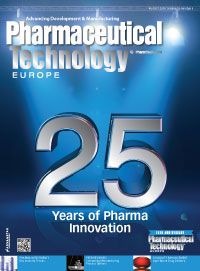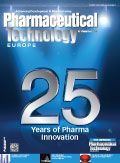Polymers for Solubility Enhancement
Pharmaceutical Technology Europe
New chemical entities with poor aqueous solubility require the use of technologies to enable sufficient oral bioavailability of these NCEs following administration.

Surveying the Landscape of Solid-Dosage Manufacturing
Experts take a look at the journey travelled thus far and where pharmaceutical manufacturing is heading over the next decade.
An increasing number of new chemical entities (NCEs) have poor aqueous solubility requiring the use of technologies to enable sufficient oral bioavailability of these NCEs following administration. The use of amorphous solid dispersions (ASDs) to increase the apparent solubility of an NCE is one area that is growing rapidly. The formation of ASDs is typically done by using spray drying or hot melt extrusion (HME) to disperse the active ingredient into a polymer matrix.

Pharmaceutical Technology Europe25th Anniversary Issue
A number of factors will determine if spray drying or HME is the preferred route for formulation, including thermal stability of the NCE, organic solvent dissolution and excipient compatibility. For the excipient, important performance factors include glass transition temperature, thermal stability, dissolution profiles in organic solvents and optimal solubilisation of the API in the ASD. Examples of excipients used in the production of ASDs include polyglycols, such as polyethylene glycol (PEG) and polyethylene oxide (PEO); polyvinyl polymers including polyvinylpyrrolidone (PVP) and polvinylpyrrolidone-polyvinylacetate copolymer (PVP-VA); acrylates and methacrylate (co-)polymers; and cellulosics including hypromellose (HPMC) and hydroxypropylmethylcellulose acetate succinate (HPMCAS).
The ability to formulate robust and stable ASDs has been aided by the recent development of functional excipients designed specifically for ASD technologies. To ensure robustness of formulation, excipients are being designed with quality-by-design (QbD) principles. This approach ensures that the impact that excipient variation has on the performance of a formulation is understood and can be controlled through proper excipient selection and specification.
In addition, excipients designed specifically for HME are being developed. These excipients, such as Soluplus from BASF and AFFINISOL HPMC from Dow enable HME by having lower glass transition temperatures and a broad thermal processing range. For spray drying, advancement has been seen in the utility of excipients by improving the solution throughput in spray dryers. An example is the introduction of AFFINISOL High Productivity HPMCAS for spray drying, in which the solid loading in a spray-drying solution can be increased by more than 1.5 times without the loss of solubility enhancement in the formulation. The rapid advancement in functional excipients and processes now designed for solubility enhancement through the formation of ASDs makes ASDs a more conventional approach for poorly soluble compounds.
AFFINISOL is a trademark of The Dow Chemical Company.
Soluplus is a trademark of BASF SE.

About the Author
William Porter III, is senior chemist, R&D, at Dow Pharma & Food Solutions.

Drug Solutions Podcast: A Closer Look at mRNA in Oncology and Vaccines
April 30th 2024In this episode fo the Drug Solutions Podcast, etherna’s vice-president of Technology and Innovation, Stefaan De Koker, discusses the merits and challenges of using mRNA as the foundation for therapeutics in oncology as well as for vaccines.